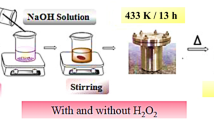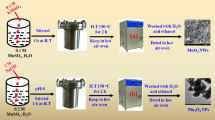Abstract
Manganese dioxide nanostructures have been synthesized by hydrothermal synthetical method. The crystallographic structure, morphology, and electrochemical properties of obtained MnO2 are examined by XRD, TEM, cyclic voltammetry, and galvanostatic charge–discharge tests. The results showed that the electrochemical properties of MnO2 were strongly affected by the crystallographic structure and morphology. The controlling crystallographic structure of MnO2 can be obtained by altering the molar ratio of KMnO4/MnSO4. The morphology was affected by the hydrothermal dwell time and temperature. The optimal synthetic conditions are as follows: the initial molar ratio of KMnO4/MnSO4 is 3:1, the reaction lasts 2 h at 120 °C, and the filling factor is 90%. In these prepared conditions, the MnO2 with the maximum specific capacitance of 259 F g−1 can be obtained. Prepared δ-MnO2 has a good layer structure and exhibits nanoflower morphology. The XRD studies show that the crystalline degree of this sample is lower, and the average grain size is about 8.3 nm. These results indicate that the product may have potential applications in areas such as electrode materials of supercapacitor and other new storing energy system.







Similar content being viewed by others
References
Chu A, Braatz P (2002) J Power Sources 112:236
Toupin M, Brousse T, Bélanger D (2002) Chem Mater 14:3946
Xu C, Li B, Du H, Kang F, Zeng Y (2008) J Power Sources 180:664
Subramanian V, Zhu H, Wei B (2008) Chem Phys Lett 453:242
Yuan A, Wang X, Wang Y, Hu J (2009) Electrochim Acta 54:1021
Zolfaghari A, Ataherian F, Ghaemi M, Gholami A (2007) Electrochim Acta 52:2806
Yan D, Yan P, Cheng S, Chen J, Zhuo R, Feng J, Zhang G (2009) Cryst Growth Des 1:218
Chen X, Li X, Jiang Y, Shi C, Li X (2005) Solid State Commun 136:94
Subramanian V, Zhu H, Vojtal R, Ajayan PM, Wei B (2005) J Phys Chem B 109:20207
Ding Y, Shen X, Gomez S, Luo H, Aindow M, Suib SL (2006) Adv Funct Mater 16:549
Xu M, Kong L, Zhou W, Li H (2007) J Phys Chem C 111:19141
Devaraj S, Munichandraiah N (2008) J Phys Chem C 112:4406
Athoul L, Moser F, Dugas R, Crosnier O, Blanger D, Brousse T (2008) J Phys Chem C 112:7270
Ni J, Lu W, Zhang L, Yue B, Shang X, Lv Y (2009) J Phys Chem C 113:54
Chen R, Zavalij P, Whittingham MS (1996) Chem Meter 8:1275
Chang JK, Huang CH, Lee MT, Tsai WT, Deng MJ, Sun IW (2009) Electrochim. Acta 54:3278
Wang X, Li YD (2003) Chem Eur 9:300
Beaudrouet E, Salle ALGL, Guyomard D (2009) Electrochim Acta 54:1240
Wei W, Cui X, Chen W, Ivey DG (2009) J Power Sources 186:543
Ghaemi M, Ataherian F, Zolfaghari A, Jafari SM (2008) Electrochim Acta 53:4607
Pang SC, Anderson MA, Chapman TW (2000) J Electrochem Soc 147:444
Kuo SL, Wu NL (2006) J Electrochem Soc 153:A1317
Toupin M, Brousse T, Belanger D (2004) Chem Mater 16:3184
Ma R, Bando Y, Zhang L, Sasaki T (2004) Adv Mater 16:918
Reddy RN, Reddy RG (2003) J Power Sources 124:330
Kijima N, Yasuda H, Sato T, Yoshimura Y (2001) J Solid State Chem 159:94
Xiao TD, Strutt PR, Benaissa M, Chen H, Kear BH (1998) Nanostruct Mater 10:1051
DeGuzman RN, Shen YF, Neth EJ, Suib SL, O’Young CL, Levine S, Newsam JM (1994) Chem Mater 6:815
Luo J, Suib SL (1997) J Phys Chem B 101:10403
Ghodbane O, Pascal JL, Favier F (2009) Appl Mater Interfaces 1(5):1130
Tian N, Zhou ZY, Sun SG (2008) J Phys Chem C 112:19801
Acknowledgment
Financial support for this work was provided by Major State Basic Research Development Program (no. 2008CB617502).
Author information
Authors and Affiliations
Corresponding author
Rights and permissions
About this article
Cite this article
Yang, Y., Huang, C. Effect of synthetical conditions, morphology, and crystallographic structure of MnO2 on its electrochemical behavior. J Solid State Electrochem 14, 1293–1301 (2010). https://doi.org/10.1007/s10008-009-0938-7
Received:
Revised:
Accepted:
Published:
Issue Date:
DOI: https://doi.org/10.1007/s10008-009-0938-7




